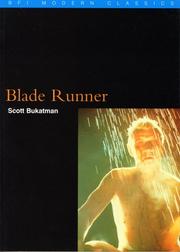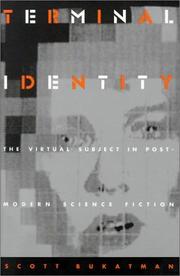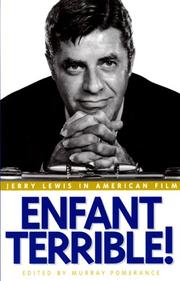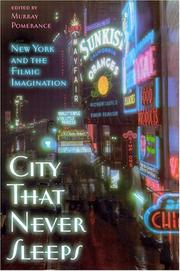| Listing 1 - 10 of 13 | << page >> |
Sort by
|

ISBN: 0822331195 9780822331193 0822331322 9780822331322 0822384892 1283064545 9786613064547 Year: 2003 Publisher: Durham (N.C.) Duke University Press
Abstract | Keywords | Export | Availability | Bookmark
 Loading...
Loading...Choose an application
- Reference Manager
- EndNote
- RefWorks (Direct export to RefWorks)
This is a collection of accessible and wide-ranging essays on cinema, the body and the experience of modernity. The text reveals how popular culture tames the threats posed by technology and urban modernity by immersing people in delirious, kinetic environments.
Scott Bukatman
---
82-312.9
---
literatuur
---
sciencefiction
---
cybercultuur
---
literatuurtheorie
---
cultuurfilosofie
---
technologie
---
beeldverhaal
---
kunst
---
film
---
videokunst
---
video
---
televisie
---
strips
---
themaparken
---
superman
---
virtuele realiteit
---
virtual reality
---
lichamelijkheid
---
Plastic Man
---
2001 A Space Odyssey
---
cyberspace
---
The Right Stuff
---
stedenbouw
---
musicals
---
stedelijkheid
---
New York
---
twintigste eeuw
---
791.5
---
Fantastische literatuur
---
Popular culture
---
Human body
---
Metamorphosis
---
Mass media
---
Motion pictures
---
Technology
---
Culture in motion pictures.
---
Populaire cultuur.
---
Technologie.
---
Spezialeffekt.
---
Virtuelle Realität.
---
Film.
---
Technischer Fortschritt.
---
Kultur.
---
History
---
Social aspects
---
Superman

ISBN: 0851706231 Year: 1997 Publisher: London British Film Institute
Abstract | Keywords | Export | Availability | Bookmark
 Loading...
Loading...Choose an application
- Reference Manager
- EndNote
- RefWorks (Direct export to RefWorks)
Scott, Ridley --- Scott Bukatman --- filmgeschiedenis --- Scott Ridley --- 791.471 SCOTT --- film --- Blade runner (Motion picture) --- Bladerunner (Motion picture) --- Film

ISBN: 0822313405 0822313324 Year: 1998 Publisher: Durham (N.C.) : Duke university press,
Abstract | Keywords | Export | Availability | Bookmark
 Loading...
Loading...Choose an application
- Reference Manager
- EndNote
- RefWorks (Direct export to RefWorks)
82-311.9 --- 82.015.9 --- 82.015.9 Literaire stromingen: postmodernisme --- Literaire stromingen: postmodernisme --- 82-311.9 Science fiction --- Science fiction --- Science-fiction américaine --- Identité (Psychologie) dans la littérature --- Réalité virtuelle dans la littérature --- Scott Bukatman --- computergrafiek --- Roeg Nicolas --- The Man Who fell to Earth --- Dick Philip K. --- Chaykin Howard --- Burroughs William --- Cronenberg David --- Blade Runner --- Scott Ridley --- Necromancer --- Gibson William --- Baudrillard Jean --- True Names --- Vinge Vernor --- TRON --- cyborgs --- Alien --- The Fly --- Bear Greg --- Blood Music --- Crash --- Limbo --- Science-fiction américaine --- Identité (Psychologie) dans la littérature --- Réalité virtuelle dans la littérature --- American fiction --- Identity (Psychology) in literature --- Postmodernism (Literature) --- Science fiction, American --- Virtual reality in literature --- History and criticism --- 791.5 --- computerspellen --- cultuurfilosofie --- cybercultuur --- cyberspace --- Dick Philip K --- film --- kunst --- lichamelijkheid --- literatuur --- literatuurtheorie --- postmodernisme --- sciencefiction --- strips --- technologie --- televisie --- video --- videokunst --- virtual reality --- virtuele realiteit --- Fiction --- Thematology --- American literature --- anno 1900-1999 --- Identity (Psychology) in literature. --- Virtual reality in literature. --- History and criticism. --- Roman américain --- Postmodernisme (Littérature) --- Histoire et critique
Book
ISBN: 9780520288034 0520288033 9780520288041 0520288041 9780520963108 0520963105 Year: 2016 Publisher: Oakland, California : University of California Press,
Abstract | Keywords | Export | Availability | Bookmark
 Loading...
Loading...Choose an application
- Reference Manager
- EndNote
- RefWorks (Direct export to RefWorks)
"Hellboy, Mike Mignola's famed comic book demon hunter, wanders through a haunting and horrific world steeped in the history of weird fictions and wide-ranging folklores. Hellboy's World shows how our engagement with Hellboy is also a highly aestheticized encounter with the medium of comics and the materiality of the book. Scott Bukatman's dynamic study explores how comics produce a heightened 'adventure of reading' in which syntheses of image and word, image sequences, and serial narratives create compelling worlds for the reader's imagination to inhabit. In Mignola's work, the imaginative space that exists on the page and within the book becomes a self-aware meditation upon the imaginative space of page and book. To understand the mechanics of creating a world on the page, Bukatman draws upon other media--including children's books, sculpture, pulp fiction, cinema, graphic design, painting, and illuminated manuscripts. Hellboy's World delves into shared fictional universes and occult detection, the riotous colors of comics that elude rationality and control, horror and the evocation of the sublime, and the place of abstraction in Mignola's art to demonstrate the pleasurable and multiple complexities of the reader's experience. Monsters populate the world of Hellboy comics, but Hellboy's World argues that comics are themselves little monsters, unruly sites of sensory and cognitive pleasures that exist, happily, on the margins. The book is not only a treat for Hellboy fans but will entice anyone interested in the medium of comics and the art of reading"--Provided by publisher.
Comic books, strips, etc. --- History and criticism --- Mignola, Michael --- Hellboy, --- Criticism and interpretation. --- History and criticism. --- Hellboy --- Mignola, Michael. --- Hellboy (Fictitious character : Mignola) --- Mignola, Mike --- Mignola, Mike. --- Comic books, strips, etc --- abstraction. --- adaptation. --- animation. --- childrens books. --- cinema. --- comics. --- darkhorse comics. --- demon. --- detective. --- fictional universes. --- folklore. --- graphic design. --- graphic novels. --- hellboy. --- horror. --- illuminated manuscripts. --- imagination. --- literary criticism. --- materiality. --- media. --- monsters. --- mystery. --- nonfiction. --- occult. --- painting. --- pleasure of reading. --- popular culture. --- pulp fiction. --- reader. --- reading. --- religion. --- sculpture. --- serial narratives. --- sublime. --- supernatural. --- visual narratives. --- Hellboy (Fictitious character from Mignola)
Book
ISBN: 1280108479 9786613520654 0520951506 9780520951501 9781280108471 9780520265714 0520265718 9780520265721 0520265726 6613520659 Year: 2012 Publisher: Los Angeles London Berkeley University of California Press
Abstract | Keywords | Export | Availability | Bookmark
 Loading...
Loading...Choose an application
- Reference Manager
- EndNote
- RefWorks (Direct export to RefWorks)
In The Poetics of Slumberland, Scott Bukatman celebrates play, plasmatic possibility, and the life of images in cartoons, comics, and cinema. Bukatman begins with Winsor McCay's Little Nemo in Slumberland to explore how and why the emerging media of comics and cartoons brilliantly captured a playful, rebellious energy characterized by hyperbolic emotion, physicality, and imagination. The book broadens to consider similar "animated" behaviors in seemingly disparate media-films about Jackson Pollock, Pablo Picasso, and Vincent van Gogh; the musical My Fair Lady and the story of Frankenstein; the slapstick comedies of Jerry Lewis; and contemporary comic superheroes-drawing them all together as the purveyors of embodied utopias of disorder.
Animated films --- Comic books, strips, etc. --- Fantastic, The, in art. --- Fantasy in motion pictures. --- Motion pictures --- History and criticism. --- Fantastique [Le ] dans l'art --- Fantasy in motion pictures --- History and criticism --- animation. --- animators. --- artists. --- cartoon artists. --- cartoons. --- cinema. --- comic books. --- comic superheroes. --- comics. --- creativity. --- emotional. --- energy. --- film studies. --- frankenstein. --- hyperbolic. --- images. --- imagination. --- inner life. --- jackson pollock. --- jerry lewis. --- little nemo in slumberland. --- media historians. --- media studies. --- my fair lady. --- pablo picasso. --- physicality. --- plasmatic possibility. --- play. --- power of imagination. --- rebellion. --- retrospective. --- slapstick comedy. --- vincent van gogh.
Book
ISBN: 9781844575220 1844575225 Year: 2016 Publisher: London New York Palgrave Macmillan on behalf of the British Film Institute
Abstract | Keywords | Export | Availability | Bookmark
 Loading...
Loading...Choose an application
- Reference Manager
- EndNote
- RefWorks (Direct export to RefWorks)
"Ridley Scott's dystopian classic Blade Runner, an adaptation of Philip K. Dick's novel, Do Androids Dream of Electric Sheep?, combines noir with science fiction to create a groundbreaking cyberpunk vision of urban life in the twenty-first century. With replicants on the run, the rain-drenched Los Angeles which Blade Runner imagines is a city of oppression and enclosure, but a city in which transgression and disorder can always erupt. Graced by stunning sets, lighting, effects, costumes and photography, Blade Runner succeeds brilliantly in depicting a world at once uncannily familiar and startlingly new. In his innovative and nuanced reading, Scott Bukatman details the making of Blade Runner and its steadily improving fortunes following its release in 1982. He situates the film in terms of debates about postmodernism, which have informed much of the criticism devoted to it, but argues that its tensions derive also from the quintessentially twentieth-century, modernist experience of the city -- as a space both imprisoning and liberating ..."--Publisher description.
Blade runner (Motion picture) --- Bladerunner (Motion picture) --- #SBIB:309H1320 --- #SBIB:309H1321 --- De filmische boodschap: algemene werken (met inbegrip van algemeen filmhistorische werken en filmhistorische werken per land) --- Films met een amusementsfunctie en/of esthetische functie: algemeen --- Blade runner (Motion picture).
Multi

ISBN: 9780814786734 Year: 2022 Publisher: New York, N.Y. New York University Press
Abstract | Keywords | Export | Availability | Bookmark
 Loading...
Loading...Choose an application
- Reference Manager
- EndNote
- RefWorks (Direct export to RefWorks)
Book

ISBN: 1617038067 1621039544 Year: 2013 Publisher: University Press of Mississippi
Abstract | Keywords | Export | Availability | Bookmark
 Loading...
Loading...Choose an application
- Reference Manager
- EndNote
- RefWorks (Direct export to RefWorks)


ISBN: 9780814768624 9780814767054 Year: 2002 Publisher: New York, N.Y. New York University Press
Abstract | Keywords | Export | Availability | Bookmark
 Loading...
Loading...Choose an application
- Reference Manager
- EndNote
- RefWorks (Direct export to RefWorks)


ISBN: 9780813541341 9780813540313 Year: 2007 Publisher: New Brunswick, N.J. Rutgers University Press
Abstract | Keywords | Export | Availability | Bookmark
 Loading...
Loading...Choose an application
- Reference Manager
- EndNote
- RefWorks (Direct export to RefWorks)
| Listing 1 - 10 of 13 | << page >> |
Sort by
|

 Search
Search Feedback
Feedback About UniCat
About UniCat  Help
Help News
News